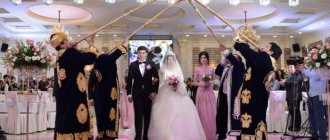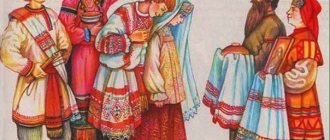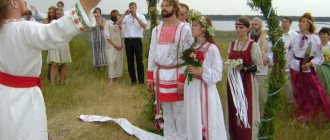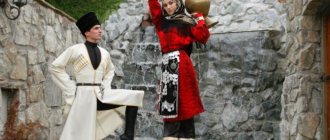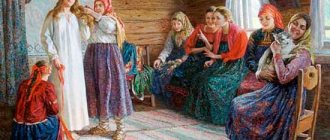Kazakh weddings are distinguished by an abundance of national traditions and rituals. The attitude towards starting a family is very serious not only among the young themselves, but also among their relatives. A couple is formed by parents long before the bride and groom meet. The candidate for the role of husband is chosen carefully, they look at the position of his family in society, heredity.
The same applies to the choice of the bride; she must meet all the requirements set by the groom's parents. With the successful approval of both parties, active preparations for the wedding begin. And the marriage process itself is carried out in accordance with all the rules of traditions that have already been established for a long time.
Kazakh wedding: viewing
Nowadays, the ancient tradition of the Kazakhs to find a bride during the bride ceremony, which is called “kyz koru”, has been practically forgotten, as well as the custom of marrying at the will of the parents. Young people now choose their own couples and marry for love. However, there were times when families with small children agreed to marry them without asking the opinion of the future bride and groom. In some cases, such agreements were concluded even before the birth of heirs, for example, if families wanted to become related.
Remembering how a Kazakh wedding was held in the past, one cannot fail to mention the bride's party. Not every resident of Kazakhstan had the right to choose a bride during the bride ceremony (“kyz koru”); it was mainly given to skilled horsemen who were able to prove their skills, as well as the offspring of wealthy or famous parents. A young man who wanted to get married, together with his friends, went to an aul where attractive girls who had reached the age of brides lived. As a rule, the potential groom and his entourage were received with honor.
During the show, girls of marriageable age competed with each other in various forms of art. They also assessed possible suitors without hesitating to express their opinions. Often there were song competitions between young ladies and gentlemen - “aitys”. If a spark ran between a boy and a girl, then it was the turn of the matchmakers, who went to the bride’s family.
Kiit
Before the matchmakers leave the bride’s house, the bride’s father traditionally gives “kiit”, that is, gifts. The groom's father receives the valuable "kiit". Other kudalar receive “kiit” based on the degree of closeness and kinship. If the family is wealthy, then “kiit” to the groom’s father is a herd of horses, many chapans, and a gift in the form of a riding horse is obligatory. The matchmakers who came from the bride’s side are not left without gifts. Of course, they are not given big gifts like the father of the bride, but they are still not ignored. As many people know, now kalyn mal is given in money, but kiit is still preserved.
Matchmaking
Matchmaking is an obligatory part of such an event as a Kazakh wedding; in the Kazakh language this ceremony is called “kuda tusu”. The role of matchmaker is traditionally assigned to the father and other close relatives of the groom. The bride's family is warned about their visit in advance and is obliged to provide generous refreshments (of course, if they like the candidate). However, matchmakers are forced to pay for entry into the girl’s house, since the female half of the family traditionally holds out a lasso in front of the door, which is removed only after the guests present gifts to the owners: pieces of expensive fabric, money.
The atmosphere at festive dinners is warm and friendly, during the meal various topics are discussed that are not directly related to the future wedding. Only when dinner is nearing completion are the matchmakers allowed to move on to the purpose of their visit. The conditions for the marriage ceremony are discussed, and the size of the bride price is established. The right to speak is given to all senior members of both families. Matchmaking, which traditionally precedes a Kazakh wedding, is also not complete without the ritual of sprinkling “shashu”. The groom's delegates are showered with sweets, cookies, small coins by the bride's relatives, and the matchmakers may also be forced to undergo various tests and take part in a fun performance.
Representatives of the groom who come to woo the girl are required to have a “korzhun” with them. This is a bag decorated with bright ribbons, beads, and coins. Inside it are gifts: dried fruits, sweets, pieces of fabric, and so on. Before the matchmakers leave, gifts are given to them, and the most valuable gift goes to the groom's father.
There is nowhere to retreat - behind the “syrga salu”
“Syrga salu” (hereinafter referred to as “syrga salu”) is held before “Kyz Uzatu” - the toy that precedes the wedding. During the ceremony, the bride puts on earrings, after which she obediently accepts all further actions. The future mother-in-law makes sirga sala. The ceremony marks the final agreement between the parties.
Matchmaking may be accompanied by another unusual tradition - “kuyryk-bauyr asatu”. The bride's relatives prepare a delicacy of fat tail, beef or lamb liver for future matchmakers. It is important to finish everything to the end without squinting even once.
Before coming to the matchmaking ceremony, the groom’s relatives must prepare a “korzhyn” (hereinafter referred to as korzhyn) - a felt or leather bag filled with gifts. Here you can put “Kuttyktaymyz” candies, which have been waiting in the wings since March 8, Soviet champagne or a bottle of vodka, and meat. Something simple like raisins, kurt, tea can also be used. You should definitely put a piece of fabric in the basket, which, if you're lucky, may one day be returned to the sender. O endless cyclicality of existence!
Bride show
The future newlywed goes to the matchmakers only after they have become acquainted with all her relatives and have agreed with them on the wedding and bride price. Before the bride leaves, the groom's representatives must present her family with a fee for the bride, which is called "korimdik" in the Kazakh language. Only after this the girl is shown to future relatives.
This is followed by a ceremony that officially assigns the girl the status of a bride. Matchmakers put earrings on her; as a rule, this honorable duty is assigned to the groom's mother. Matchmakers should also give gifts to other family members, mainly gold jewelry: necklaces, brooches, rings.
Asatad
“Asatady” - “Treat” visiting matchmakers. They just treat you to fat tail fat. Today this dish looks completely different. Nowadays it is served on skewers, so it can be eaten without any residue, as is customary. During the meal, matchmakers wish each other: “Bauyrday zhakyn – kuyryktay tatti bolayik.” “Let’s be as close to each other as liver, and tender as fat tail fat.” Afterwards, already in the status of official “kudalar”, the parents of the newlyweds perform the ceremony “Tos kagystyru”, where the fathers of the lovers hug. In Kazakh it sounds like this: “Kuda men kudany tos kagystyru.”
After the rituals kuyryk-bauyr and tos kagystyru, the ritual “Syrga salu”, “Putting on earrings” is held, in which only women take part. The bride is led out by her two daughters-in-law (zhenge) without earrings. Two daughters-in-law from the groom's side are already getting down to business. They put the earrings they brought on the bride. In fact, the mother of the groom can also wear earrings. It depends on the region where the girl will go as a bride. After kissing her and congratulating her, the matchmakers give payment for showing the bride “Kyzdyn korimdigi”.
Also matchmakers with the words: “Kalynsyz kyz bolsa yes, kadesiz kuyeu bolmaidy.” “There may be a bride without a dowry, but there is no groom without gifts.” Thus, matchmakers from the groom’s side present the required gifts to the bride’s relatives:
“Oli - tiri” “Dead-alive” - sacrificed meat, which is divided among the relatives of the newly-made bride.
“Toi mala” “Animal for a wedding” - at the moment these rituals are given in monetary terms.
“Sut akysy” “Payment for milk” - here they give a gift to the mother of the bride.
“Zhigit tuye” “Dzhigit camel” - in this ritual you need to give a gift to the bride’s father in the form of a camel.
Kalym
Bride price is something without which in the old days a Kazakh wedding could not take place. Traditions tell the candidate for the girl's hand in marriage to present 47 head of cattle to her parents. Nowadays this rule is rarely observed; it is enough to put 47 small items in the gift bag that the matchmakers give to the bride’s family. The number of heads of cattle demanded for a bride in the past also depended on the wealth of the families intending to become related. For the daughter of a large bai they often paid up to 1000, while the poor were content with 5-6 heads as a bride price.
Today, such a tradition as the financial assistance provided to newlyweds by parents has been preserved. Custom orders the bride's relatives to provide her with a dowry, including carpets, bedding, dishes, and so on. The groom's relatives must allocate money to the young family to purchase furniture.
Obviously, not every engagement ends in marriage. If the groom, after the visit of the matchmakers and the payment of the bride price, suddenly decides to get married, without having the grounds provided for by custom, he cannot count on the return of the bride price. Moreover, the family of the deceived girl has the right to force the flighty young man to pay a fine, the amount of which is negotiated separately. A different situation arises if the contract is not respected by the bride or her relatives. In this case, the girl’s family must not only fully return the ransom they paid, but also compensate for the violation of the contract by paying a fine.
What types of kuda tusu exist
Since ancient times, Kazakh culture has had a tradition of “besik kuda”. Besik kuda is when children are matched from birth. There was also a type of matchmaking called “karzy kuda”. This is when a matchmaker on the groom's side gives his daughter as a bride to a matchmaker on the bride's side. In addition, if matchmakers give their daughters in marriage, then this type of tradition is called “suyek zhangyrtu” (“bone renewal”). Previously, to marry a girl, an educated man who knew history well was sent to the village. Women did not interfere in this process.
“Bel kuda” - for example, if two friends wanted to be matchmakers, but could not (for example, one of them did not have children), then in the future, if kids appear, they plan to become matchmakers.
It is also worth recalling that in the old days, matchmakers dipped their hands in the blood of a sacrificial animal in order to become blood-deeply close to each other. Nobody does that now. There was also a sign “un zhagu” “to smear with flour” - the Kudalar smeared their faces with flour in order to be even closer. “Esik-tor korsetu” - the meaning of this tradition is as follows: the bride’s relatives went to the village to visit the groom for the holiday.
If the kudalar show self-confidence, they say, the bride is now all ours, and you, apparently, are giving her to us in the manner: “Zhol maksaty - zhetu, kyz maksaty - ketu.” Translation: “The goal of the road is to get there, and the goal of the girl is to leave.” To which the matchmakers could receive an answer from the girl’s parents: “Uidin ishine syigan kyz, syrtka and siyady.” Translation: “A girl who fits inside the house will fit outside,” or they said: “And you have to pay for what you receive.”
At the moment, matchmaking is carried out differently in different regions of Kazakhstan. For example, in the northern regions of the country, bride price is not given much importance. But in the southern regions, this tradition is considered very important, and they adhere to it down to the smallest detail. If we talk about the West, then there is no bride price at all.
Bride's outfit
All over the world, girls getting married are sensitive to the choice of outfit, and brides who are about to have a Kazakh wedding are no exception. According to tradition, the bride's dress should be red, but nowadays Kazakh women can choose a white robe. Over the dress, which usually has wide and long sleeves, a velvet vest embroidered with ornaments is worn; it can be any color.
The bride’s headdress, called “saukele,” is an element without which it is difficult to imagine such an event as a Kazakh wedding. A photo of a girl wearing a traditional headdress can be seen above. “Saukele” looks like a work of art; custom orders it to be decorated with pearls and rubies, and made of expensive fabrics (velor, velvet). Beads, fringe, and silver coins are also used as decorative elements. The upper part of the headdress is decorated with a bun made from eagle owl feathers, the edges are trimmed with fur (fox, sable, mink). The wealth of “saukele” allows you to demonstrate the financial capabilities of the family.
“Saukele” looks so luxurious that friends and relatives invited to the wedding are ready to give small gifts for the right to admire the bride dressed in this headdress.
Kuyryk-bauyr
Kuyryk-bauyr is a traditional treat made from liver and fat tail fat. This dish indicates that the matchmaking went well. Also, this is some proof that the matchmaking took place. This technique imposes obligations on parents on both sides. If the matchmaking is interrupted due to some circumstances, the guilty party pays a penalty and returns the bride price received. In shape it looks like this: it looks like a sandwich, but fat tail fat is placed on top of the liver.
Groom's outfit
Not only the bride is obliged to carefully prepare for such an event as a Kazakh wedding. According to custom, the groom's costume should surpass, in terms of wealth, the vestments of any guest. A man getting married must stand out from the crowd, which is helped by a special headdress, the upper part of which is decorated with eagle owl feathers. Also, traditions tell the groom to appear at the wedding ceremony in high-heeled boots, throwing a red caftan called “chapan” over his shoulders.
Nowadays, Kazakhs practically no longer dress so magnificently; no exception is made even for such an event as a Kazakh wedding. Modern customs favorably allow young people to wear a snow-white shirt and trouser suit. It is desirable that the suit fits perfectly, so it is sewn to order, the color does not play a special role. However, many men still do not forget about the national headdress, which emphasizes the splendor of the ceremony.
The groom who is about to have a Kazakh wedding should not only worry about his outfit. Customs tell him to bring with him “that mala,” the name given to the cattle for the wedding, which will be slaughtered for the feast. The quantity depends on the wealth of the family; it can be several rams, horses or cows. They also take other gifts with them, for example, expensive fabrics, fruits, tea. It is curious that the attitude of the bride's family towards the son-in-law depends on the amount that he can allocate for offerings. If the girl's relatives remain dissatisfied with the wealth of gifts, customs allow them to express their dissatisfaction. As a rule, this function is assumed by the wives of the bride's brothers.
Choosing a wedding day
Even when choosing a day for a wedding ceremony, Kazakhs take into account the traditions that developed many centuries ago. Most often, holidays are held in the last days of the summer season. At this time, religious fasting ends, and fruits and vegetables are in abundance, so this is the best time for such an event as a Kazakh wedding. Traditions and history show that Kazakhs can get married in the fall. In spring and winter, weddings are held less frequently.
Modern brides and grooms continue to choose the full moon period for their wedding ceremony. The reason for this decision is the bright nights, ideal for holding night games and competitions, which have been a mandatory element of the holiday for many years.
It is not always possible to guess the weather, but it also plays an important role when choosing a wedding date. It is believed that if a husband and wife get married on a cloudless, sunny day, they will not know sadness or quarrel with each other. Whereas bad weather is regarded as a bad omen, which, however, many Kazakhs do not pay attention to.
What should the future “kelin” be prepared for?
The wife remains in her husband's house, and now she is a full-fledged member of the newfound family. The guests left, and the daughter-in-law had new responsibilities. According to the established tradition, “kelin” (hereinafter – kelin) must pass the final obstacle course - perform “kelin shay”. The subject demonstrates her skills to her husband’s relatives: the most skilled kelins have a photographic memory, so they will never confuse the bowl, and they will even guess any preference of a participant in the feast.
Kazakh wedding traditions are heterogeneous - each region is famous for its originality, which gives rise to variability in norms. However, most of the listed traditions and rituals have survived to this day and are practiced everywhere.
Seeing off the bride
Seeing off a girl (“kyz uzatu”) is a beautiful ceremony with which a Kazakh wedding has begun from time immemorial. Traditions tell the bride's family to laugh and shed tears on this day. Joy should be caused by the fact that the daughter getting married has grown up to be beautiful and smart. The source of sadness is the need to part with the girl, who will henceforth belong to another family.
Matchmakers take the bride out of the house very early, often her departure coincides with sunrise. The tradition did not arise by chance, because sunrise throughout the world is associated with the beginning of a new life. The family will not let their daughter leave home without the traditional farewell song, which is called “Costasu Heat.” The number of matchmakers is also important; it should be odd. Usually 5-7 matchmakers come for a girl, but more people are possible. The procession is led by the chief matchmaker, who calls himself “bas kuda.” The bride will have to treat this person with respect throughout her life.
How does matchmaking and engagement work?
Currently, some traditions have undergone changes or are completely outdated. For example, now newlyweds make their own decisions about who will be their life partner. Previously, everything was different. The first stage was matchmaking.
Matchmakers have always treated this process with great respect and prepared for it no less carefully than for the wedding ceremony itself. Matchmaking has been the key to good relations between families for many years.
The essence of the process is as follows: a young man and his relatives went to the house of a girl who was considered as a future wife. But they could get into the house on condition that they paid a ransom.
The matchmaking date was agreed upon in advance, so matchmakers on both sides had time to prepare.
After the ransom, according to custom, the groom was supposed to receive warmth from the bride's house. This was done as follows: the oldest woman in the house had to bring her palms to the hearth and warm them, then put her hands on the face of the young guest.
In this way, the comfort of this house was transferred to the new one in which the couple would live. After this, national Kazakh wedding songs were played. Until the agreement is concluded between the matchmakers, the bride does not leave her room.
She was allowed to appear before the guests only after the ram had been slaughtered and the festive table had been set. This moment is the most important for the young couple, since they saw each other for the first time. After the guy and the girl met, the holiday continued, which was always accompanied by songs. There were toasts to the newlyweds and congratulations from relatives.
Modern customs are already devoid of intrigue, since the young people know each other before matchmaking.
wedding ceremony
“Neke Kiyar” is a ritual without which a Kazakh wedding cannot take place. Traditions dictate that a mullah be invited to perform the wedding ceremony. A bowl filled with water and covered with a cloth is placed in front of this person. Sometimes sugar and salt are added to the water; according to beliefs, this brings happiness to the newlyweds and protects them from adultery. Relatives and friends invited to the ceremony gather around the mullah. He says prayers, after which the bride and groom, in the presence of witnesses, confirm their consent to the marriage.
Sharia law states that a Kazakh wedding cannot take place if a girl is pregnant. Customs recommend postponing the ceremony until the child is born. Nowadays, this rule is no longer so strictly observed, especially when it comes to the first months of pregnancy, when it can still be hidden.
Farewell ceremony
Having entered into marriage, a girl must solemnly say goodbye to her father’s house; the ceremony is called “koshtasu”. “Koshtasu” is an important part of such an event as a Kazakh wedding, the customs and traditions of which are still not forgotten by the residents of Kazakhstan. The newlywed must say heartfelt words of farewell to all family members without exception: mother, father, brothers, sisters, as well as other relatives living in the house.
Also, the girl certainly sings a farewell song, with the help of which she expresses her regrets. The newlywed should express pity that she was born not a boy, but a girl, which is why she has to leave her home, while her brothers can stay with their parents. She also promises to visit her family soon and wishes the relatives good health and happiness.
We must not forget about another interesting custom that is associated with such a ceremony as the Kazakh wedding, the features of which often surprise representatives of other nationalities. The newlywed should not appear in her parents' house for a whole year after the wedding. This is done to make the process of getting used to the girl’s new home as simple as possible. However, this does not mean that the bride will not be able to see her parents and other relatives for a whole year. The main thing is that the meeting does not take place in the father’s house, therefore, the rule will not be considered violated.
Celebration
The most important ritual among the Kazakhs is “neke kiyar”, a mullah is invited to it. This person reads prayers and asks both newlyweds for their consent to the marriage. Having received positive answers, the marriage became valid.
The farewell ceremony of the bride to her father’s house was considered obligatory; it is called “koshtasu”. The people of Kazakhstan honor this ritual to this day. A young wife should turn to each member of her family and offer warm words of gratitude and sincerely say goodbye to all relatives without exception.
Another prerequisite is a farewell song performed by the bride. The meaning of the song is to express pity and sadness that the girl is breaking up with her relatives. But at the same time, she promises them that she will visit them often and wishes them health for many years to come.
But it is worth considering one important feature. Now the wife could visit her relatives only after one year, and not earlier.
After saying goodbye to his stepfather's house, the celebration continued at the groom's house. A caravan moving towards a young guy's house stops before reaching its destination.
The bride was surrounded by young girls who led her into the house, covering her with a large scarf. The girl goes behind the screen; no one should have seen the newlywed’s face before the official part of the holiday.
When all the guests were already gathered, the girl was taken out from behind the screen, she, in turn, bowed to each family member, accepting a gift in return. At the end of the holiday, the mother-in-law removed the scarf from the bride, thereby dedicating her to her wife.
The wedding ceremony took place the next day in the mosque, where the newlyweds drank water from a sacred bowl.
At the groom's house
What happens after the Kazakh wedding ends, how does the newlywed get acquainted with the new home? The arrival of the girl is also arranged with all solemnity, the ceremony is called “kelin tusiru”. According to tradition, the entire village must take part in welcoming the bride. Interestingly, it is not customary for a newlywed to be dropped off at the doorstep of the house in which she and her husband are to live. She is dropped off quite far from the village, and her future neighbors come out to meet the girl. They escort the bride into the house without allowing her to reveal her face.
This is not the end of the traditions that govern a Kazakh wedding, the peculiarities of which may surprise foreigners. The newlywed must definitely step over the threshold with her right foot, otherwise family life will not work out from the very beginning. In the house, she and the accompanying women are showered with sweets and congratulations are offered. A sumptuous feast follows, to which all acquaintances are invited. The meal is accompanied by fun contests and competitions. The bride is not shown to the guests right away; she spends some time in the house behind a special screen.
LiveInternetLiveInternet
1. Where to Tusu (matchmaking)
Matchmaking. An ancient, unforgotten, obligatory tradition of the Kazakh people. The young man's father and close relatives go (sometimes without the young man's father) to woo the girl. The matchmaking process was quite difficult and interesting. The arrival of matchmakers is called “kuda tusser”. The girl's father, notified in advance of the matchmakers' arrival, invites his family and friends. The matchmakers are solemnly received. After the girl’s father gives the go-ahead, both parties present each other with gifts according to tradition: kuda attanar, kuda tartu, at bailar, kuyryk-bauyr, etc. The most important representative of the matchmakers is called “bas kuda” (bass is the main one), the fathers of the bride and groom are called bauyzdau kuda, i.e. the closest ones. “Bas kuda” (the main matchmaker) traditionally takes care of the girl even after the wedding.
She will call him "agaeke" (uncle), and he will be obliged to always take care of her. As a daughter-in-law, she reveres him all her life. “Kuda tusu” is the most highly revered, significant one, carrying a special national flavor.
Before the wedding, the groom's side gives the bride's father a "kiit". It includes: a horse, a robe made in the national style and other various gifts. Also on this day, festivities are held in the bride’s house, where a ram is slaughtered, and relatives and friends are invited. But neither the groom nor the bride should be present in the house; their families negotiate everything for them. The agreement between the parents of the newlyweds takes place in an ornate and somewhat pompous manner. During the dastarkhan meal, the main matchmaker on the groom’s side sedately starts a conversation, with jokes and jokes on the topic: “you have goods, we have a merchant.”
2. Kalym
The groom and his family must pay the bride price. Previously, bride price was paid in cattle (horses).
The size of the bride price depends on the financial situation of the groom. But in our modern society, the bride price has lost its original meaning. All this grew into an agreement to help young people create their family life. Each party agrees on what they will give to the newlyweds for their wedding. It could be an apartment, a car, a dacha, furniture, money. The custom of paying kalym has become more of a beautiful modern custom. 47 small gifts are placed in Korzhyn (small chests). All this was replaced by the ancient ritual Kalym Mal, in which 47 heads of cattle were given - for a groom with average income (if the groom was rich, then 77 heads, and if poor - 17). After this ritual, you can set a wedding day. It is usually prescribed after 15-30 days.
3. “Zhertys-toy”
A pre-wedding event organized by the groom's family. At this holiday, gifts intended for the groom are sorted out. On this day, guests give various items that can be useful in everyday life, during the first time of family life.
4.
The groom's side goes to the bride.
Taking with you, wedding gifts - “dzhartys”. On this day, the bride's family prepares a rich festive table. In honor of the future son-in-law, various traditional Kazakh sweets (baursak, kurt) are baked. After the meeting, the groom goes to the yurt, where he continues to have fun with his friends, but without the bride. But on this night, relative, from the bride’s side, bring her to the groom. They must spend the night together. This will mark the beginning of married life.
5. Kyz Uzatu (seeing off the bride from her father’s house) and Zhigitten Toi (wedding)
The newlyweds go to the mosque, where the mullah reads the prayer of Blessings from Allah to unite the bride and groom. By the way, the Kazakh wedding ceremony itself, unlike other Muslim peoples, does not require consecration by a mullah. It is enough for half of the bride and groom, as well as all those present, to sing a wedding song.
Kazakh wedding song. Aushadiyar
“Aushadiyar” is a wedding song (zhyr). A traditional wedding song (zhyr) is sung to a specific tune and has a special educational value. “Aushadiyar” is a decoration and a particularly solemn moment of the toy. This is usually an example of art. Unfortunately, in our time in Kazakhstan, “aushadiyar” has been completely forgotten. “Aushadiyar” is dedicated to a young couple who are crossing the threshold of a new life. “Aushadiyar” contains good advice and examples of education in national traditions
Aushadiyar - let's say once, the Wicked does not make us happy. Respecting ancestors, the honor of descendants awaits. Aushadiyar - let's say two, lovers have their own will. The beauty has such a slender figure, a long braid... Aushadiyar - four, Youth is beautiful in pairs. Be faithful to their oath. After this ceremony, the bride and groom are already considered husband and wife. The groom's parents, as a sign that they accept their son's bride into their family, put earrings on the bride - Syrgalar. At a wedding, a girl can perform a song - a farewell to her carefree girlhood. After this, Ak Zhol spreads out, which means a white road. This road leads from the bride to the Husband, to a new family, to a new life... The girl, saying goodbye to her relatives, bows low to her parents and relatives. She must walk along this path without looking back, otherwise her life will not be so happy and successful. After this, the bride and groom take him to his family. They live there until the wedding - Toy. During a wedding, the newlyweds should listen to all toasts while standing. Bowing our heads, listening, parting words to family life. It’s curious, but throughout the wedding the bride and groom should not talk.
6. Betashar - opening the face.
The bride is covered with a white scarf or cape. She is held by the elbows on both sides by Zhengeler, the brothers' wives. The bride's face should not be visible, so the fabric should be opaque. The toastmaster, or specially invited Akyn, sings a song praising the beauty, stateliness and dignity of the bride. The song also contains lines that she should honor the groom’s relatives and be an exemplary wife and an exemplary housewife. The musical accompaniment is playing the domra. After the end of the impromptu song, Akyn or the toastmaster uses the tip of the domra to reveal the face of the bride - Betashar. At the same time, the bride is showered with sweets, coins and rose petals - Shashu. Sweets and coins are taken apart by children and adults - it is believed that these sweets and coins are “for good luck.”
7. Saukele
A special decoration of a Kazakh wedding is undoubtedly the national wedding dresses of the bride and groom. The most expensive and beautiful headdress is considered to be a girl’s headdress - “saukele”. Saukele is a Kazakh wedding women's headdress. Saukele is a cone-shaped hat about 70 centimeters high. The frame of the headdress is made of thick felt. On top it is covered with velvet, velor, silk or satin and decorated with fur, gold, silver, precious stones or pearls. The top of the saukele is crowned with fluffy feathers of an eagle owl, and long pendants are attached to the sides. . The decor of the headdress also contains valuable beads and the indispensable mink or ermine fur. A white veil is also sewn to the saukele, which covers the bride’s face. The wedding dress is necessarily decorated with hand embroidery, which carries the magical symbols of the Kazakh people. A vest embroidered with gold is worn over the dress, and the face is always covered with a veil.
In the old days, Kazakhs made saukele for their daughters long before they got married. This headdress was one of the obligatory items of the bride's dowry. It was a symbol of the beginning of a new, family life and was passed down from generation to generation. After the wedding, a girl could wear a saukele on holidays until the birth of her first child.
Creation of a new home in a new Kazakh family. Otau koteru.
Creation of a new hearth. The Kazakh people have the concept of “otau keteru”, which means marriage, creating a new family. According to custom, parents prepare the house for both their son and daughter. The dowry of a “Zhasau” girl includes a yurt – “otau”. The new home should bring happiness to the young family, so they decorated the yurt and tried to make it cozy. Relatives and friends, relatives on the mother’s side (nagashi), and neighbors took part in this. Aul residents take an active part in the interesting and obligatory ritual “otau keteru.” The Shanyrak (yurt dome) is raised by tying the bakan (pole) with white cloth. Shanyrak is assigned to be raised by a respected person.
The revered women are the first to enter the otau, pour oil into the fire of the hearth, coat the threshold and doorposts with oil. The first dastarkhan is served with a rich treat.
Face Revealing Ritual
The ceremonial entrance of the bride is the next stage of such a holiday as a Kazakh wedding, the traditions and stories of which go back centuries. The newlywed, hiding her face under the veil, is brought out to the guests at the height of the feast, by which time all the people invited to the celebration have already gathered. The ceremony of revealing the girl’s face is called “betashar” and is always accompanied by traditional songs. Next, the newlywed officially meets her husband’s relatives, respectfully listens to their wishes for health and happiness, and friendly advice. After this, the newly made husband and wife finally turn into a separate unit of society.
There were times when the bride did not have the right to attend the feast that invariably ends a Kazakh wedding. Modern customs and traditions no longer force the newlywed to wait for her wedding night in a separate room, remaining under the watchful eye of her husband’s mother. Brides these days mostly have fun on the occasion with everyone else.
"Betashar"
Betashar is a traditional Kazakh ceremony that is performed before the big wedding on the part of the groom, or after the groom brings the bride home immediately after uzat. Usually, the bride is seated behind a white screen and also with a white shawl so that her face is not visible. Then, when all the invited guests have gathered, she is solemnly led out in a beautiful dress to the betashar ceremony. The entire betashar process takes place to the accompaniment of dombra and a specially written song. Kuishi mentions the names of all the guy’s relatives in verse, and the young bride must make an honorary salem with each mention. At this time, having heard their name, the uncles, aunts, sisters and brothers of the groom put money into the basket.
After the ceremony was completed, the mother-in-law approached the bride and took off her shawl. The shawl is supposed to be handed over to the women present at the celebration. Having divided the shawl equally, they tied the dishes with this cloth for storing kumus or shubat. They also gave the same basket of money, but only to someone who was going to get married soon.
Interesting Facts
The above describes how a Kazakh wedding is held; photos taken during the festive ceremonies can also be seen in the article. However, not all interesting facts regarding such events are listed. For example, few people know that once upon a time girls became brides at the age of 13-14, and boys were considered ripe for marriage at 14-15. Starting a family at such a young age was considered useful; from a moral point of view, young people did not have time to commit indecent acts.
An ancient custom did not allow a guy and a girl who belonged to the same family to become husband and wife. It is not surprising that many Cossacks today know their ancestry very well and are familiar with relatives up to the seventh generation. The age of the people wishing to get married was also taken into account. It was unacceptable for the bride to be more than 8 years older than the groom. A man could be 25 years older than his future wife. Now such restrictions are observed less strictly than in past times, however, they have not yet been completely forgotten.
Another interesting custom concerns toasts, without which a Kazakh wedding is not complete. The right to make toasts is granted only to older relatives; speeches by younger relatives at the wedding feast are considered an insult.
These are the most interesting information about such a grandiose event as a Kazakh wedding. Customs, traditions, photos - the article contains all the information regarding this festive event.
Kudalyk
Matchmaking after a big wedding is done by the groom’s side in order to properly meet the matchmakers. There is even a saying - “Kudalyktyn belgisi - barys kelis”, “The sign of matchmaking is mutual visits.” But now, the groom’s side often conducts kudalyk on the day of the party, and kudalyk is performed for the bride’s relatives during their arrival at the big wedding. The reason for this action is lack of time, since there are a huge number of people at Kazakh weddings.
It doesn’t matter when Kudalyk takes place, because its main purpose is the exchange of gifts. The Kazakhs say: “Kudalyk belgisi - kiit, konys belgisi - beit” “The sign of matchmaking is gifts, and the sign of housewarming is graves,” and of course, a warm and friendly atmosphere. We also say that any Kazakh: “Respects and honors the matchmaker like a god.” In the main dish, beshbarmak, a lamb's head is served to the matchmaker. Also, during matchmaking, Kazakhs want the matchmaker to become like a friend, and the matchmaker to be like their closest friend, sister.
The exchange of gifts is called “Kiit”. In this ritual, gifts are made from clothes. Matchmakers exchange lists in advance indicating the clothing sizes of each member of the relatives for whom they will buy gifts. They buy various kinds of things: outerwear, for example coats, chapans, suits, shirts, blouses, etc. Today, this tradition is carried out differently in different regions of Kazakhstan. Some matchmakers say to each other: “Perhaps we won’t dress each other.” “Sir bezdi, bez sizd kiindirmey ak koyayyk.” However, in any case, both sides of the matchmakers are not left without gifts.
